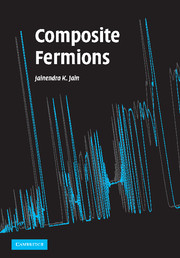Book contents
- Frontmatter
- Contents
- Preface
- List of symbols and abbreviations
- 1 Overview
- 2 Quantum Hall effect
- 3 Landau levels
- 4 Theory of the IQHE
- 5 Foundations of the composite fermion theory
- 6 Microscopic verifications
- 7 Theory of the FQHE
- 8 Incompressible ground states and their excitations
- 9 Topology and quantizations
- 10 Composite fermion Fermi sea
- 11 Composite fermions with spin
- 12 Non-composite fermion approaches
- 13 Bilayer FQHE
- 14 Edge physics
- 15 Composite fermion crystals
- Appendixes
- References
- Index
12 - Non-composite fermion approaches
Published online by Cambridge University Press: 07 December 2009
- Frontmatter
- Contents
- Preface
- List of symbols and abbreviations
- 1 Overview
- 2 Quantum Hall effect
- 3 Landau levels
- 4 Theory of the IQHE
- 5 Foundations of the composite fermion theory
- 6 Microscopic verifications
- 7 Theory of the FQHE
- 8 Incompressible ground states and their excitations
- 9 Topology and quantizations
- 10 Composite fermion Fermi sea
- 11 Composite fermions with spin
- 12 Non-composite fermion approaches
- 13 Bilayer FQHE
- 14 Edge physics
- 15 Composite fermion crystals
- Appendixes
- References
- Index
Summary
Analogies play a central role in physics. The CF theory was motivated by the analogy between the fractional and the integral quantum Hall effects. Other analogies were proposed prior to the CF theory. As discussed in Section 5.5, the Laughlin wave function was motivated by the Jastrow wave functions used earlier for 4He superfluids. A “composite boson” approach modeled the physics of the Laughlin wave function after Bose–Einstein condensation. A “hierarchy” approach proposed understanding the FQHE at non-Laughlin fractions by using the Laughlin wave function as the basic building block. Both the hierarchy and composite boson approaches take the Laughlin wave function as their starting point. These ideas, as seen below, are distinct from the CF theory.
This chapter also presents certain other non-CF works. The simple Jastrow form of the Laughlin wave function allows for certain technical simplifications; in particular, a mapping into a classical plasma enables alternative, but 1/m-specific, derivations of certain properties that were obtained in earlier chapters by other means. In addition, we describe two quantitative approaches for excitations without using composite fermions: Laughlin's wave functions for the quasiparticle and quasihole at v =1/m, and Girvin, MacDonald, and Platzman's “single-mode approximation” for neutral excitations.
We also briefly outline the hydrodynamic theory of Conti and Vignale, and Tokatly, which treats the correlated liquid state in the lowest Landau level as a continuous elastic medium, and formulates its collective dynamics in terms of the displacement field.
- Type
- Chapter
- Information
- Composite Fermions , pp. 363 - 393Publisher: Cambridge University PressPrint publication year: 2007

